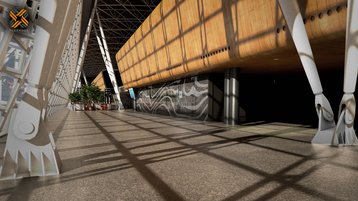We have one site deployed so far, and we’re going to deploy a couple more this year,” says Andrew Lindsey, CEO and co-founder of Flexnode. "A large part of this process was creating a strong foundation.”
Flexnode designs, deploys, and operates Edge data centers. The company launched its first and currently only data center last year in Long Island City, New York, but has ambitions to deploy more so it can serve customers beyond the East Coast.
The site has a 1MW data room (80kW capable racks); liquid-cooled IT (precision immersion and now cold plate); GPU solutions and CPU solutions operational; digital twin running.
Lindsey, who co-founded the company in 2019 along with Robert Mazer, said: “If you look at what has happened in the built environment when you see various solutions come about, you need to have those partners on board long before you start going to market and deploying things.”
He adds that the company wants to deploy one or two more data centers by the end of the year.
Transition to the data center market
Linsdey’s background is in construction engineering. He previously worked at Alpha Consortium, a company founded by his father, that focuses on mission-critical projects.
It was while working there that he identified what he saw as a challenge in the data center construction industry.
“The interest came about for Flexnode when we discovered that project timelines weren't getting shorter, they were getting longer,” he says. “We were seeing this in full view, where land was getting much more difficult to find in these data center hub locations, and if you could find it, it was prohibitively expensive.”
Sourcing power for these data centers was becoming a challenge for the industry, says Lindsey, as is the overall supply chain, which he says was getting “blocked up.”
“We can’t train up people fast enough to be able to deliver the kinds of infrastructure that we're looking at over the next five years,” he says.
“We're talking about north of a billion square feet in five years, just nutty amounts of infrastructure on any measure. And as the power companies are saying to us today, this is a once in a multigenerational problem.”
Flexnode, however, wasn’t created to build traditional data centers, but rather a strategy focused around developing a modular data center approach, designed to be flexible and scalable.
The company had identified this approach as the most sustainable long-term strategy for its own data center growth plans. Lindsey says it had also become aware of the perception from the public around data center construction in recent years.
“We have groups now that are far more aware of that 600,000 sq ft facility that's sitting in their backyard and communities are pretty angry about the fact that they bought this new house that had this pretty view, and now they can't see more than 30 ft because there's a 60 ft wall behind it. Five years ago this was just rumblings and now it's in full view.”
Take me to the Edge
Requirements around the build-out of data centers have also led to a rethink of how these buildings need to be constructed.
Building data centers at the Edge is the way to combat some of the challenges that the industry faces, Lindsey argues.
“We see Edge as a way to activate infrastructure very quickly, where today, as you know, we have a wildly low vacancy rate,” he says.
“That should continue through the next several years, and people still need data, so we see this as a way to scale out where we have now. We’re now on track over the next five years to be able to scale out at gigawatt scale.”
Edge is already supporting several use cases at present, such as the mining industry in remote areas where power isn’t always easy to come by. It’s also tipped to underpin autonomous vehicles, smart grids, and medical advancements in the coming years.
Designed to be deployed wherever
Flexnode’s data centers are designed to be deployed easily, in various locations, indoor or outdoor, claims Lindsey.
“We wanted to create an integrated platform that allows for our customers to build and deploy data centers, with an experience that's much more akin to building and buying a car,” he explains, noting that Flexnode focuses on connecting three key parts.
“The first part was an industrialized building system that is designed for disassembly, configurability, adaptability, and designed to go anywhere.”
The second part, he says, is focused on its fully digitized process which helps its customers design and configure their data centers. The final part, he adds, is the ecosystem of partners Flexnode partners with, spanning engineering and construction.
Flexnode works with several partners to deploy its data centers, which Lindsey says allows the company to build everywhere. The company works with Arup Engineering, SHoP Architects, UK-based structural engineering firm Thornton Tomasetti, Jensen Hughes, JE Dunn Construction, and Boyce.
US businesses have to be prepared for an array of natural disasters, and Lindsey adds that Flexnode has designed its modular data centers to be able to survive in some of the harshest environments, notably category five hurricanes, tornados, and earthquakes.
He explains that Flexnode integrates a system that can collapse down into components, which can fit in a variety of spaces. The data centers can go from four to 36-rack configurations.
“We have a fully digitized process that starts from the earliest stages of design and configuration,” he says. “That digital process continues through the entire lifecycle of a data center.”
Indeed, Lindsey says his company creates a digital twin of every data center it builds. “What it is for us is everything from a configurator to a management and controls platform, to a training platform for our service people to a monitoring platform for our customers,” he says. “And that together really makes up a digital twin.”
Investment
Flexnode raised $8.85 million in a seed funding round in March 2023. The money will go towards helping the company scale out its operations, says Lindsey.
The raise came after Flexnode secured a $3.5m grant from the US Department of Energy as part of the COOLERCHIPS program in May of last year.
Working for ARPA-E – the energy unit of the US government’s Advanced Research Projects Agency innovation agency – it will develop a prefabricated, modular Edge data center with a novel manifold microchannel heatsink, a chassis-based hybrid immersion cooling approach, and an additive manufacturing-enabled dry cooling heat exchanger system. This will all be housed in a topology-optimized container.
The investment follows years of hard work from the company’s founding team, Lindsey says. “For the first couple of years it was our own money,” he says. “We bootstrapped pretty heavily, put a lot of resources into it. And then we started seeking external capital, which is where we’ve had some raises.”
Lindsey tells DCD that the company aims to deploy more across the US later this year, but won’t just deploy data centers for the sake of it. “We’re not planning on deploying these data centers like Bird Scooters,” he says, referring to the US micromobility company which has scooters operating across many US states.
“It’s just not our approach. Because it’s a building, we don't see it as a very, very large appliance, and as a result, we respect the communities that we go into.”
He says Flexnode seeks to “offer value to the broader communities that we go into,” adding: “This isn't a lift, ship, drop, and leave - it’s about integrating into those communities as well.”
AI and the challenges it presents
The emergence of AI has presented challenges across all industry sectors, and the data center business is no exception.
But as AI promises so much, the technology will need a lot of compute power to operate. It will require a huge number of high-density servers to accommodate AI workloads, and this means many operators are looking at how their facilities are designed.
Lindsey states that Flexnode is aware of the challenges that AI poses for the industry.
“It's a huge problem,” he says about the challenges around AI. “We’ve had a lot of discussions that are ongoing around groups that are rolling solutions out at a building scale that support AI.
“But these buildings are still facing the same project challenges that every other one has confronted before them. Those five to seven-year project timelines are still real for those other buildings, regardless of how cool their technology is inside their facility.”
He notes that it’s difficult for older data centers to retrofit their existing buildings because of the demands of AI.
Flexnode has worked with clients to address the growing demand for AI capabilities as part of its phased AI Edge data center approach.
According to Flexnode, the expansion focuses on air-cooled systems, providing immediate relief to the capacity constraints. It says that this initial phase is designed with the future in mind, “allowing for a smooth transition to liquid cooling systems as the demand for AI capabilities grows and the need for more efficient cooling solutions becomes apparent.”
International ambitions
Looking further into the future, Lindsey wants to take Flexnode global, specifically in the EMEA and APAC regions.
“I will say that we have international expansion in our sights, both because of several opportunities that are developing in Europe and in the APAC area, but also because we're designed for it,” says Lindsey.
“We have the ability to go into locations that have heat reuse requirements, and sustainability requirements. These are things that we are truly tuned for.”
He says this is likely to take two to three years.
As for what’s on the horizon for the rest of this year, he says another Series A round is being lined up.
“We are planning to start this within 2024,” he adds. “We’re planning to build out our constellation of sites where we can support customers to deploy anywhere and everywhere.”
Although he admits the transition into the data center world has been challenging at times, Lindsey is keen for Flexnode to leave its stamp on the market.
“Has it been stressful at times? Absolutely. We have gone into the deepest and darkest corners of the built environment,” he says.
“But I will also say that it has been unbelievably exciting. We have a real opportunity to revolutionize the built environment, not only in the world of IT, but the truly built world of environment, methodologies, and technologies.”





